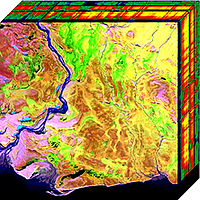
Photo from wikipedia
ABSTRACT The application of adequate nitrogen (N) fertilizers to grass seed crops is important to achieve high seed yield. Application of N will inevitably result in over-fertilization on some fields… Click to show full abstract
ABSTRACT The application of adequate nitrogen (N) fertilizers to grass seed crops is important to achieve high seed yield. Application of N will inevitably result in over-fertilization on some fields and, concomitantly, an increased risk of adverse environmental impacts, such as ground- and/or surface-water contamination. This study was designed to estimate the N status of two grass seed crops: red fescue (Festuca rubra L.) and perennial ryegrass (Lolium perenne L.) using images captured with an unmanned aerial vehicle (UAV) mounted multispectral camera. Two types of UAV, a fixed-wing UAV and a multi-rotor UAV, operating at two different heights and mounted with the same multispectral camera, were used in different field experiments at the same location in Denmark in the period from 432 to 861 growing degree-days. Seven vegetation indices, calculated from multispectral images with four bands: red, green, red edge and near infrared (NIR), were evaluated for their relationship to dry matter (DM), N concentration, N uptake and N nutrition index (NNI). The results showed a better prediction of N concentration, N uptake and NNI, than DM using vegetation indices. Furthermore, among all vegetation indices, two red-edge-based indices, normalized difference red edge (NDRE) and red edge chlorophyll index (CIRE), performed best in estimating N concentration (R2 = 0.69–0.88), N uptake (R2 = 0.41–0.84) and NNI (R2 = 0.47–0.86). In addition, there was no effect from the choice of UAV, and thereby flight height, on the estimation of NNI. The choice of UAV type therefore seems not to influence the possibility of diagnosing N status in grass seed crops. We conclude that it is possible to estimate NNI based on multispectral images from drone-mounted cameras, and the method could guide farmers as to whether they should apply additional N to the field. We also conclude that further research should focus on estimating the quantity of N to apply and on further developing the method to include more grass species.
Journal Title: International Journal of Remote Sensing
Year Published: 2019
Link to full text (if available)
Share on Social Media: Sign Up to like & get
recommendations!